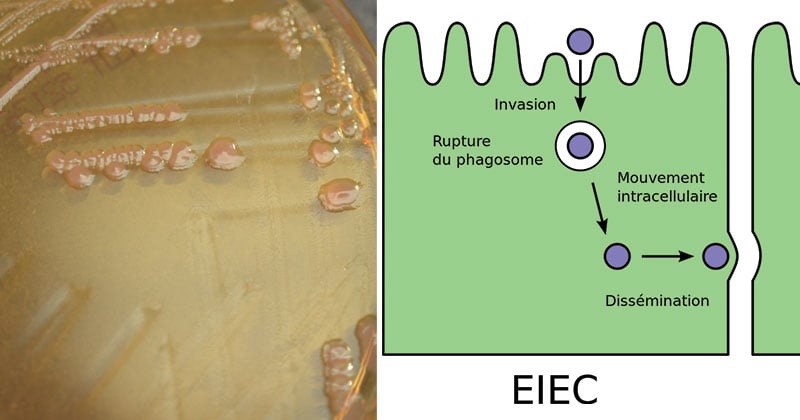- Enteroinvasive E. coli (EIEC) strains are rare in both developed and developing countries.
- EIEC infections are characterized by a period of watery diarrhea that precedes the onset of scanty dysenteric stools containing blood and mucus.
- Pathogenic strains are primarily associated with a few restricted O serotypes: O124, O143, and O164.
- EIEC strains are biochemically, genetically, and pathogenetically related closely to Shigella spp.

Interesting Science Videos
Disease Caused
- It causes ulceration of the bowel, dysentery (diarrhea with mucus and blood, called bacillary dysentery resembling Shigellosis).
Mode of Transmission
- EIEC outbreaks are usually foodborne or waterborne, although person-to-person transmission does occur.
- The infective dose of EIEC in volunteers is higher than that for Shigella spp. and thus the potential for person-to-person transmission is lessened.
Pathogenesis of Enteroinvasive E. coli (EIEC)
EIEC pathogenesis comprises
- epithelial cell penetration,
- lysis of the endocytic vacuole,
- intracellular multiplication,
- directional movement through the cytoplasm, and
- extension into adjacent epithelial cells
- EIEC is not toxigenic, but invasive.
- A series of genes on a plasmid mediates bacterial invasion (pInv genes) into the colonic epithelium. The epithelial cell invasion is most importantly mediated by a plasmid-coded antigen called virulence marker antigen (VMA).
- The bacteria then lyse the phagocytic vacuole and replicate in the cell cytoplasm.
- Movement within the cytoplasm and into adjacent epithelial cells is regulated by formation of actin tails (similar to that observed with Listeria).
- This process of epithelial cell destruction with inflammatory infiltration can progress to colonic ulceration.
Clinical Features
- The bacteria are able to invade and destroy the colonic epithelium, producing a disease characterized initially by watery diarrhea.
- A minority of patients progress to the dysenteric form of the disease, consisting of fever, chills, malaise, abdominal cramps, and blood and leukocytes in stool specimens.
Diagnosis
EIEC strains can be difficult to distinguish from Shigella spp and from other E. coli strains, including nonpathogenic strains. In general, identification of EIEC entails demonstrating that the organism possesses the biochemical profile of E. coli, yet with the genotypic or phenotypic characteristics of Shigella spp.
- Detection of VMA by ELISA
- HeLa cell invasion assay
- Sereny test (inoculation of bacterial suspension into guinea pig eyes produces conjunctivitis)
- Compared with other E. coli strains, EIEC are biochemically atypical being non-motile, lactose non· fermenters and negative for lysine decarboxylase.
Treatment
- Patients with profuse diarrhea or vomiting should be rehydrated.
- Antibiotics to treat non-STEC diarrheagenic E. coli include fluoroquinolones such as ciprofloxacin, macrolides such as azithromycin, and rifaximin.
References
- Murray, P. R., Rosenthal, K. S., & Pfaller, M. A. (2013). Medical microbiology. Philadelphia: Elsevier/Saunders
- Parija S.C. (2012). Textbook of Microbiology & Immunology.(2 ed.). India: Elsevier India.
- Sastry A.S. & Bhat S.K. (2016). Essentials of Medical Microbiology. New Delhi : Jaypee Brothers Medical Publishers.
- https://cmr.asm.org/content/11/1/142
- https://www.amboss.com/us/knowledge/Diarrheagenic_E._coli
- https://www.ncbi.nlm.nih.gov/pubmed/7546449
- https://wwwnc.cdc.gov/eid/article/22/7/15-2080_article
- https://wwwnc.cdc.gov/travel/yellowbook/2018/infectious-diseases-related-to-travel/escherichia-coli-diarrheagenic
